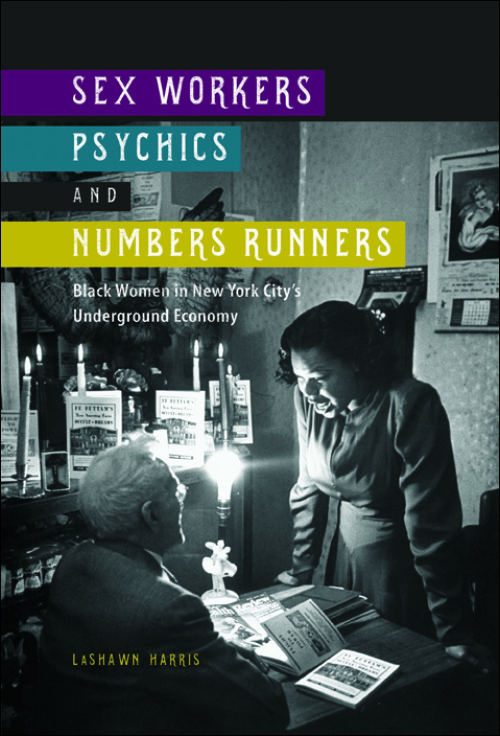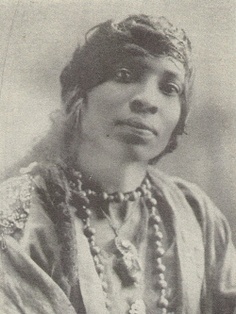Shifting Ground: Writing Working-Class Black Women’s History from Below
Today is the fourth day of our roundtable on LaShawn Harris’s new book, Sex Workers, Psychics, and Numbers Runners: Black Women in New York City’s Underground Economy (University of Illinois Press, 2016). On Monday, blogger Keisha N. Blain introduced the book and its author followed by remarks by Julie Gallagher on Tuesday and Shannon King on Wednesday. Dr. Harris is an Assistant Professor of History at Michigan State University. Completing her doctoral work at Howard University in 2007, her area of study focuses on twentieth century United States History. Harris has recently published articles in the Journal of African American History, Journal for the Study of Radicalism, and the Journal of Social History. Her first book, Sex Workers, Psychics, and Numbers Runners, examines the public and private lives of an all-too-often unacknowledged group of African American female working-class laborers in New York City during the first half of the twentieth century.
In today’s post, Talitha LeFlouria highlights the strengths of Harris’s bottom-up approach and use of diverse primary and secondary sources. She also identified areas for future research on black women and the underground economy.
 Sex Workers, Psychics, and Numbers Runners: Black Women in New York City’s Underground Economy is a path-breaking addition to the growing body of literature on working-class black women. In this study, LaShawn Harris recovers the lesser-known experiences of African American women who engaged in turn-of-the-twentieth century New York City’s informal economy. Rigorously researched and well-written, this impressive study emphasizes the interiority and “exteriority” of black women’s lived experiences and labor in the sex trade, “supernatural consulting” business, and numbers game.
Sex Workers, Psychics, and Numbers Runners: Black Women in New York City’s Underground Economy is a path-breaking addition to the growing body of literature on working-class black women. In this study, LaShawn Harris recovers the lesser-known experiences of African American women who engaged in turn-of-the-twentieth century New York City’s informal economy. Rigorously researched and well-written, this impressive study emphasizes the interiority and “exteriority” of black women’s lived experiences and labor in the sex trade, “supernatural consulting” business, and numbers game.
In this book, Harris highlights the ways in which “off-the-books” workers navigated New York City’s informal labor market, homing in on the social, political, economic variables, and challenges that influenced black women’s entrée into the informal labor sector. Some sought to escape the confines and economic restrictions of domestic work. These women sought employment options that would allow for financial growth and stability for their families. For others, social and “sexual aspirations,” labor independence, and a sense of personal autonomy influenced their exit from the formal labor market. Nevertheless, working off the grid came with its own risks and obstacles. Women were routinely arrested, assaulted, raped, killed, and cheated out of their wages.

In five compelling chapters, Harris ushers her reader through New York City’s underground economy. In Chapter One, she provides an overview of black women’s lived and laboring experiences in New York’s informal labor market. In Chapter Two, she charts black women’s engagement in the city’s illegal numbers industry, focusing primarily on Madame Stephanie St. Clair’s role as the “Number’s Queen” of Harlem. In Chapter Three, she explores the role of “supernatural laborers.” In Chapter Four, she explores black women’s role in New York’s sex trade. And, in Chapter Five, she outlines the ways in which black political and neighborhood activists contested the immoral social and economic activities taking place in various parts of New York City.
Writing this history of black women from below was no easy feat for Harris. She admits that one must possess great patience, creativity, and flexibility to weave together the stories of women who have been excluded from the archive, or have deliberately erased their documentary footprints to evade detection or legal recourse for their illegal business practices. Hence, to penetrate the arcane underworld of the informal economy, Harris uses a wide range of interdisciplinary sources, including “white and black race reform and charitable organization records; anti-vice investigation reports; Federal Writers’ Project (FWP) interviews; immigration and naturalization records; and city and state court and prison records and inmate parole case files” (12).
As a historian who studies the working lives of incarcerated black women in the post-Civil War South, I, too, have confronted the challenges that await the scholar who dares write working-class black women’s history from below. One must be prepared to take risky methodological choices, and to use “questionable” sources to inform one’s analysis. It is the use of what historian Kali Gross refers to as the “elastic analytical framework” that allows for the broadening of conceptual and empirical boundaries, essential to the telling of these histories.
While Harris’ study clearly struck an intellectual chord with me, it resonated with me on a personal level as well. I was drawn back to memories of my childhood in Ypsilanti, Michigan, a small industrial town, filled with working-class and almost middle class African Americans. I vividly remember the “numbers man,” Plug, who would coast through our apartment complex in his navy blue Fleetwood Cadillac. Like clockwork, he would visit the homes of his faithful customers. My mother always grimaced when she saw him coming. She chided our next door neighbor for playing with Plug. She resented him for selling false hopes to poor folks, who were blinded by his glitz, thinking his “good fortune” would somehow rub off on them. He wasn’t Robin Hood to her. He was robbing the hood. To make matters worse, Plug’s children attended college, and he lived in a “fancy” house with his wife. These facts perturbed my mother. And the fact that he wore suits when he made his runs made her even more frustrated.
To my mother, Plug was a criminal. But to others, he was a model of middle class success. Harris’ study reveals the nuanced and highly complex ways in which working-class black women (and men) interpreted and performed respectability. She highlights the ways in which underground workers used their earnings from illicit labor to “support and reinforce traditional aspects of racial uplift” (3).

Madame Stephanie St. Clair, the “Numbers Queen” of Harlem, is one of the best documented examples of an urban black woman who “made her own way” in the city’s number’s racket. She became one of Harlem’s renowned numbers bankers. Whereas in most urban enclaves, or even small towns like Ypsilanti, men like Plug ruled the game, St. Clair was afforded the same economic opportunities as her male counterparts. She also engaged in “community uplift” and black institutional building, a practice that added to her reputation as the “Digit Queen.”
After reading Sex Workers, Psychics, and Numbers Runners, I am convinced that future studies of black women and the underground economy will emerge out of this work. One area of exploration might include the study of black women and informal economy in the urban South. Another might involve analyzing the lived and laboring experiences of underground entrepreneurs who worked out of their homes, including hairdressers, seamstresses, and caterers. The opportunities for investigation are far and wide, characterizing of the depth of Harris’s pioneering work.
Talitha LeFlouria is associate professor of African American Studies in the Carter G. Woodson Institute for African-American and African Studies at the University of Virginia. She specializes in the study of working-class black women and incarceration in the post-Civil War South. She is the author of the award-winning book, Chained in Silence: Black Women and Convict Labor in the New South (UNC Press, 2015). Follow her on Twitter @TLeFlouria.
Copyright © AAIHS. May not be reprinted without permission.
Great read! I too am aware of the challenges of writing about women who have not been central to or have been excluded from the archive. I understand how hard it is to write about folks who were not interested in having people know about their activities. I am also intrigued by alternative Black economies. This review makes me want to get a copy of Dr. Harris’s book right now!
Excellent review, Dr. LeFlouria. Reading your review makes me want to write another review. LOL. One of the many things I appreciate about this book is its authenticity, sincerity, and honesty about the people. She rendered fully dimensioned historical subjects. I think her work and others challenge the so-called “ghetto” literature as a form of scholarship and as a discourse. This ghetto discourse often conflates black people with urban space, so that ghetto isn’t historical and structural but embodied by black folks.